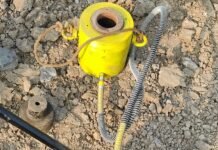Contents
SAFETY IN GAS CUTTING AND WELDING
ACETYLENE CYLINDERS:

SAFETY IN GAS CUTTING
- Maroon in color.
- Acetylene gas (C2H2) is dissolved in acetone (liquid) and stored at 250 psi, in a specially designed cylinder.
- Acetylene cylinders have a volume of 8.5 m3.
Acetylene cylinder pressure between 17.5767 Kg/cm2(250 PSI) to 13.3583 kg/cm2 (190 PSI)
Acetylene working pressure 10PSI (0.70307 kg/cm2) (Do not exceed 15 psi)
CLICK HERE FOR > JSA
CLICK HERE FOR > HIRA
CLICK HERE FOR > SAFETY PLAN
CLICK HERE FOR > MONSOON SAFETY PLAN
CLICK HERE FOR > COVID-19 SAFETY PLAN
OXYGEN CYLINDER:-
- Oxygen is a colorless, tasteless, and odorless gas and is slightly heavier than air.
- The oxygen cylinder is black in color.
- Oxygen stored at 2200 psi.
- Oxygen cylinders have a volume of 6.9 m3.
A standard oxygen cylinder pressure between 154.6753 kg/cm2(2200 PSI) to 77.33765 kg/cm2 (1100 PSI)
Oxygen working pressure 20 PSI (1.40614 kg/cm2) to 25 PSI(1.75767kg/cm2)
CYLINDER STORAGE:-
- Well ventilated room.
- No open flame in the store.
- 10 m distance from oxygen and acetylene cylinders.
- No materials that are prone to spontaneous combustion.
- Should not be stored in direct sunlight.
Flashback safety in gas cutting
Regulators:-
UNLOADING FROM TRUCK:-
- Never drop.
- Use wooden Ramp and coir matters (50cm thick).
- Keep the top of the cylinder up.
- Roll the cylinder keeping it upright.
Lifting cylinders by crane:-
- Use of cradle.
- 4-leg bridle sling.
- D-shackle and lifting lug.
Use of Cylinder trolley:-
- Shifting cylinders at the site.
- Avoid Rolling & Manual carrying.
- Use trolley.
RIGHT OPERATION:-
- Keep the cylinder upright and away from hot jobs.
- Fix the DA and oxygen regulator to the respective cylinders after ensuring free from dirt or grease.
- Connect the cutting hoses to the regulators and cutogen with hose clamps. Blue or black hoses for oxygen and red for DA.
- Open the cylinder and check for leakage by soap water test at the joints. The same to be followed for the oxygen cylinder. Close the cylinders.
- Purge the oxygen line and then the DA line one after the other and close the valves.
- Open the DA regulator, the torch valve and light the gas. Then open the oxygen valves to the required pressure.
- After cutting start closing from oxygen and then DA.
HAZARDS IN GAS CUTTING:-
–FLASHBACK.
–BACKFIRE.
–GENERAL FIRE.
–EXPLOSION.
A FIRE ON CYLINDER:-
- try to put out the fire.
- close the valve if it gets put out.
- otherwise, inform fire dept. and keep on cooling the cylinder with water.
- never pour water on hot.
EXPLOSION:-
Reasons:
- Fire on the cylinder (pouring water on the hot cylinder).
- Cylinder exposed to external heat.
- Rough handling.
PPE FOR SAFETY IN GAS CUTTING AND WELDING
- Helmets with face shields.
- Black glass – din value 4 to 5.
- Leather gloves.
- Leather Apron.
- Safety shoes.
SAFETY IN WELDING:-
- The body of the welding machine should be earth.
- The terminals of the welding cables should be provided with lugs and kept tight.
- The joints in the cables should be made with terminals, kept tight, and well insulated with heat-resistant tape.
- The cable should be free from joints at least for a length of three meters from the electrode holder to avoid shock hazards.
- Other electrical cables should not be kept laid with welding cables, to avoid insulation damage.
- For the return lead, the only proper cable should be used. Using rods, angles, channels, etc. Should be avoided.
- Never change electrode with bare hands or wet gloves, when standing on wet floors.
HAZARDS:-
- Fire
- Shock
- Health hazards
HEALTH HAZARDS:-
- Exposure to various toxic gases generated during welding may produce one or more of the following effects:
- Inflammation of the lungs (chemical pneumonitis)
- Pulmonary edema (swelling and accumulation of fluids)
- Chronic bronchitis.
- Asphyxiation.
Preventive Measures
- Elimination or substitution.
- Modification of the processor engineering.
- Local exhaust ventilation.
- General dilution ventilation.
- Personal protective equipment,
Personal Protective Equipment:-
- FACE SHIELD WITH ATTACHED HELMET
- GOGGLES, FACE-SHIELD.
- DIN VALUE OF BLACK GLASS 12 to 14.
- LEATHER HAND GLOVES (FLAME RESISTANT)
- LEATHER APRON & LEG GUARD.
- SAFETY SHOE.
HAZARDS AT SITE:-
- Working overhead.
- Working in confined spaces.
- Welding or cutting tanks or vessels.
- Tripping hazards.
Compressed Gas Cylinders Toolbox Safety Topics















this is really an amazing blog. Good luck for your next blog
Thanks
very nice…
Please send me sir file
OK
Send me sir
I have got more knowledge about safety from your site. Thank you very much.
Yes it is very kind job . I am trying to study for nebosh igc. Hope fully I will be passed nebosh igc
I am thankful to you for coming up with this useful information. Your description along with the pics let me there itself. And we are leading welding and cutting suppliers
Reach us;